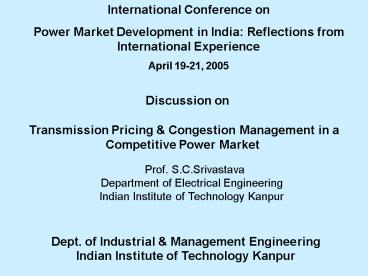Discussion on Transmission Pricing - PowerPoint PPT Presentation
1 / 20
Title:
Discussion on Transmission Pricing
Description:
Discussed Basic Principles & Few Methods of Transmission Pricing. ... and needs simplification for practical applications such as using zonal rather ... – PowerPoint PPT presentation
Number of Views:635
Avg rating:3.0/5.0
Title: Discussion on Transmission Pricing
1
Discussion on Transmission Pricing
Congestion Management in a Competitive Power
Market
Prof. S.C.Srivastava Department of Electrical
Engineering Indian Institute of Technology Kanpur
2
Major Highlights of Prof. Bialeks Presentation
- Discussed Basic Principles Few Methods of
Transmission Pricing. - LMP reflects the cost of transmission losses and
opportunity costs due to transmission constraints
(such as line flow constraints during congestion) - LMP Method quite involved and needs
simplification for practical applications such as
using zonal rather than nodal pricing. - LMP may not recover capital cost completely.
Methods based on MW-km or TNUoS (Transmission
Network Use of System in UK) can be used.
3
Few Issues associated with Transmission Pricing
and Congestion Management
- How to form Price Zones?
- Bids of regulating power market are used for
congestion management. Identification of cluster
of buses most effective in congestion alleviation
will minimize number of Gencos/Discos in
congestion management. - Role of reactive power readjustment in congestion
management. - Allocation of transmission loss make up and
congestion cost amongst market participants.
4
A Nodal Price Based Bus Clustering and Network
Reduction Technique(by H.K. Singh S.C.
Srivastava, IEEE PES GM, San Fransisco,12-16 June
2005)
- Criteria
- Nodes in a group must have relatively close
marginal prices, and should be geographically
close to each other. - For a change in system loading, the differential
marginal prices must be relatively close, - Steps
- OPF performed on full system and real power
marginal prices (MP) are computed. - Overall system load is increased by 5 and MP
computed using OPF. Differential marginal prices
are calculated. - Initial node grouping is done based on marginal
prices. - Groups are fragmented considering differential
prices. - Groups are further modified considering
geographical proximity. - Groups are reduced to equivalent nodes using REI
reduction technique
5
Group formation for an Indian system
6
Average marginal prices of groupsand at
theirequivalent nodes
7
Cluster/Zonal Based Congestion Management Using
Real and Reactive Power Rescheduling(Ashwani
Kumar, SC Srivastava and SN Singh, A Zonal
Congestion Management Approach Using Real and
Reactive Power Rescheduling, IEEE Trans. on
Power Systems, Vol.19,No.1, Feb.2004, pp.
554-562.)
- The congestion cluster based congestion
management approach utilizing both real and
reactive power rescheduling is presented.
- Two sets of sensitivity indices have been
proposed - Real power transmission congestion distribution
factors (PTCDFs) Reactive power transmission
congestion distribution factors (QTCDFs)
- The most sensitive clusters/zones are obtained
as - The union of most sensitive zones obtained on the
basis of PTCDFs and QTCDFs
8
Congestion Clusters based on PTCDF for 39-bus
system(Line34-14)
9
Congestion Clusters based on QTCDF for 39-bus
system(Line 34-14)
10
Combined Congestion Clusters for 39-bus System
11
Congestion Cost Allocation Using a Unified Power
Flow Tracing Approach(H.K.SinghNetwork
Reduction, Congestion Management and Transaction
Allocation Algorithms in Electricity Market,
Ph.D. Thesis,IIT Kanpur, August 2004.)
- Conventionally MW flow and MVR flow are traced
separately - A new unified method suggested to trace the
apparent power flow - A complex set of distribution factors defined for
MVA flow tracing, based on Proportional sharing
principle. This involves
- Line flows obtained from base load flow
- Lossless real and reactive power flow networks
formed separately - Two networks are combined and modified.
Fictitious lines and buses added.
12
Tracing Methods Using Proportional sharing
principle (Work by Bialek)
- Determination of shares of inflows in terms of
outflows and outflows in terms of inflows
Inflows
Outflows
13
Power tracing algorithm
Inflow to node i from line i-j can be
calculated using Proportional sharing principle
as,
14
Power tracing
- Constraint Sending end power Receiving end
power
AC power flow on 4 node network
15
Real power tracing
Make the system lossless
Lossless real power flow
16
Reactive power tracing
Making a lossless reactive power system
Lossless reactive power flow with fictitious nodes
17
Network modification for flow direction uniqueness
Case 1 Pij Qij same direction Pji Qji same
direction
Case 2 Pij Qij same direction Pji Qji
opposite direction
18
Case 3 Pij Qij opposite direction Pji Qji
same direction
Case 4 Pij Qij opposite direction Pji Qji
opposite direction
19
Demonstration on 4 node system
20
Transmission Pricing Congestion Management in
India
- Indian power sector has five REBs SEBs. As part
of reforms process, vertical unbundling in
several states have taken place and number of
Discoms have been formed. - Centralized Dispatching through RLDCs and SLDCs.
States get power from Central Generating units as
per their entitlement. Frequency Linked ABT in
force at the regional level. - Congestion management is the responsibilities of
RLDCs and SLDCs. - Electricity Act 2003 stipulates introducing
competition at different levels and open access
to transmission Distribution wires. - Zonal Postage Stamp Method for Transmission
Pricing. Zones divided based on distance traveled
(1 stamp for every 100km). - Issues related to charges for congestion has to
be worked out.

